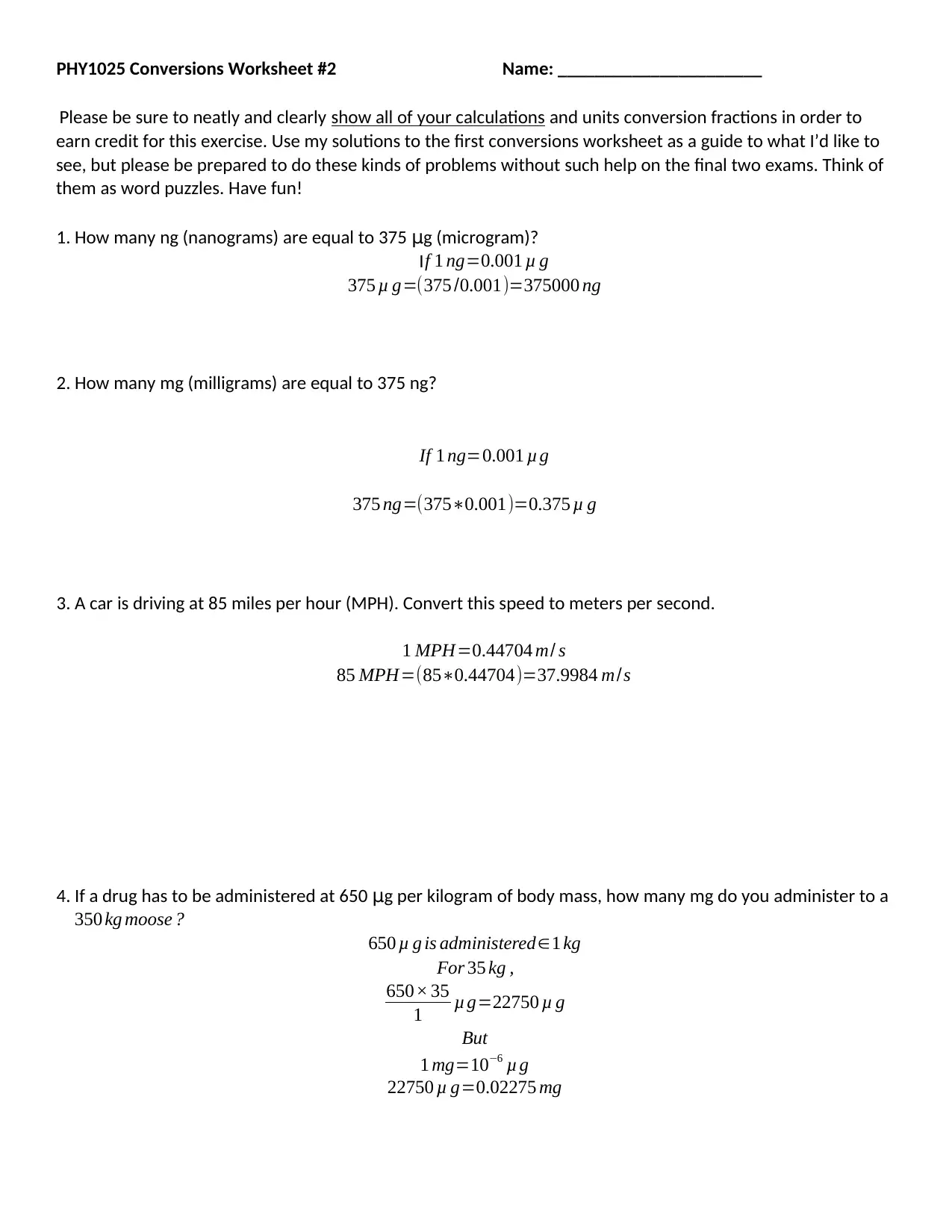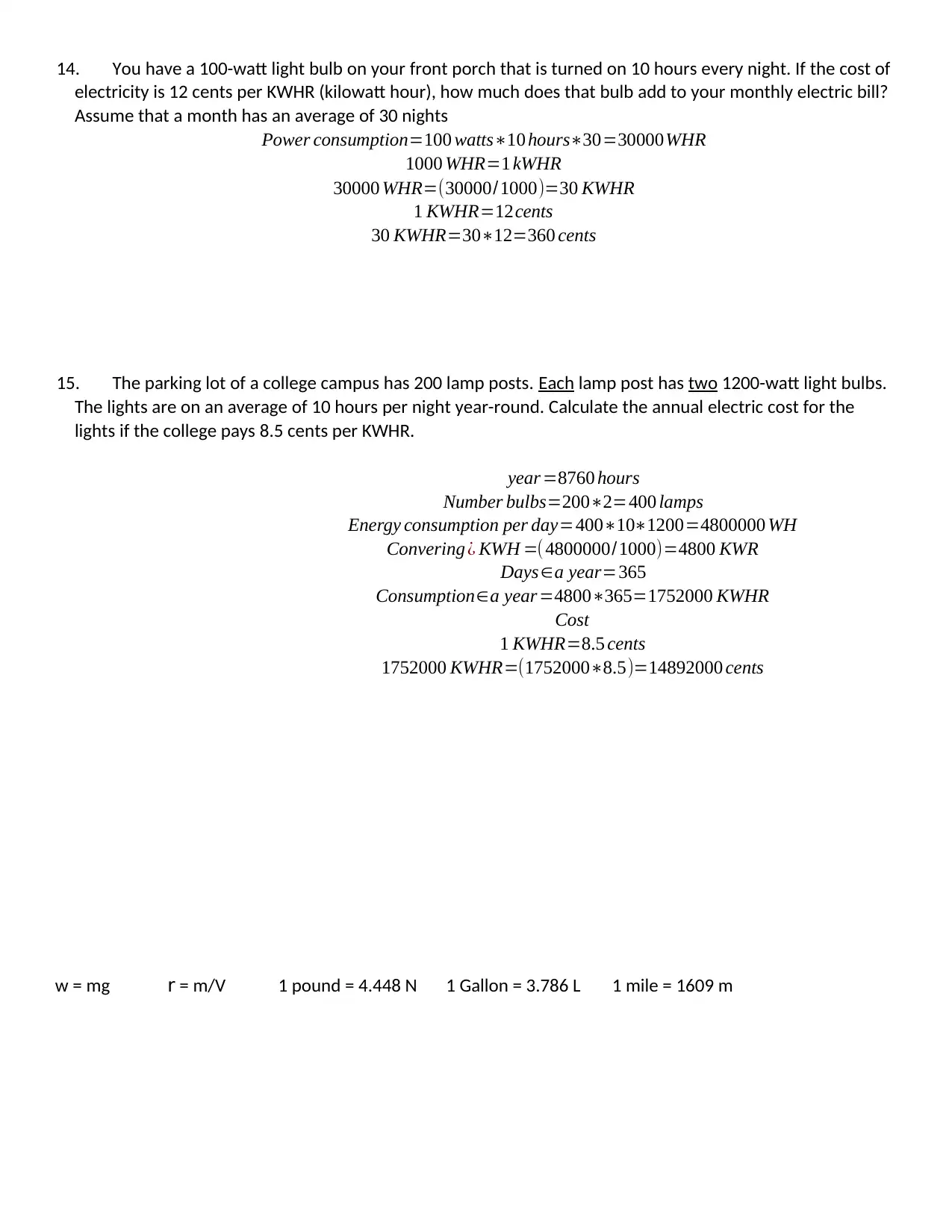PHY1025: Conversions Worksheet #2 - Physics, Units Conversion
VerifiedAdded on 2022/08/21
|5
|652
|29
Homework Assignment
AI Summary
This document provides solutions to a physics conversions worksheet, focusing on unit conversions and problem-solving. The worksheet includes a variety of problems, such as converting between nanograms and micrograms, miles per hour to meters per second, liters per second to gallons per minute, and calculating the mass and weight of air in a classroom. It also involves dosage calculations for medication, fuel consumption calculations for vehicles, and density calculations for a block of metal. Furthermore, the worksheet addresses electricity consumption and costs associated with light bulbs and parking lot lights. The solutions demonstrate the step-by-step process of solving these problems, including unit conversion factors and calculations.

PHY1025 Conversions Worksheet #2 Name: ______________________
Please be sure to neatly and clearly show all of your calculations and units conversion fractions in order to
earn credit for this exercise. Use my solutions to the first conversions worksheet as a guide to what I’d like to
see, but please be prepared to do these kinds of problems without such help on the final two exams. Think of
them as word puzzles. Have fun!
1. How many ng (nanograms) are equal to 375 μg (microgram)?
If 1 ng=0.001 μ g
375 μ g=(375 /0.001)=375000 ng
2. How many mg (milligrams) are equal to 375 ng?
If 1 ng=0.001 μ g
375 ng=(375∗0.001)=0.375 μ g
3. A car is driving at 85 miles per hour (MPH). Convert this speed to meters per second.
1 MPH=0.44704 m/ s
85 MPH=(85∗0.44704)=37.9984 m/s
4. If a drug has to be administered at 650 μg per kilogram of body mass, how many mg do you administer to a
350 kg moose ?
650 μ g is administered∈1 kg
For 35 kg ,
650× 35
1 μ g=22750 μ g
But
1 mg=10−6 μ g
22750 μ g=0.02275 mg
Please be sure to neatly and clearly show all of your calculations and units conversion fractions in order to
earn credit for this exercise. Use my solutions to the first conversions worksheet as a guide to what I’d like to
see, but please be prepared to do these kinds of problems without such help on the final two exams. Think of
them as word puzzles. Have fun!
1. How many ng (nanograms) are equal to 375 μg (microgram)?
If 1 ng=0.001 μ g
375 μ g=(375 /0.001)=375000 ng
2. How many mg (milligrams) are equal to 375 ng?
If 1 ng=0.001 μ g
375 ng=(375∗0.001)=0.375 μ g
3. A car is driving at 85 miles per hour (MPH). Convert this speed to meters per second.
1 MPH=0.44704 m/ s
85 MPH=(85∗0.44704)=37.9984 m/s
4. If a drug has to be administered at 650 μg per kilogram of body mass, how many mg do you administer to a
350 kg moose ?
650 μ g is administered∈1 kg
For 35 kg ,
650× 35
1 μ g=22750 μ g
But
1 mg=10−6 μ g
22750 μ g=0.02275 mg
Paraphrase This Document
Need a fresh take? Get an instant paraphrase of this document with our AI Paraphraser

5. A sprinkler system pumps 27 liters per second of water. Convert this volume flow rate to gallons per minute
(GPM).
1 litre/ second=15.8603 gpm
27 litres /second =(27∗15.8603)=427.959 gallons per minute
6. Your heart pumps about 70 mL of blood per beat and beats an average of 80 times per minute. How many
gallons of blood does your heart pump every hour?
mL /minute=70/80
1 mL/min=0.00026 gpm
7 /8 mL /min=(7 /8∗0.00026)=2.275 × 10−4 gpm=0.01365 gallons per hour
7. A one-time intravenous antibiotic is to be given at a dosage of 750 μg per kg of body mass. How many
milligrams would you administer to a 300-pound patient?
1 pound=0.453592kg
300 pounds=(300∗0.453592)=136.078 kg
μ g administered=750 μ g∗136.078=102058.5 μ g
102058.5 μ g=102.0585mg
8. A classroom is about 3 meters high, 20 meters wide and 30 meters long. If the density of air is 1.29 kg/m3,
what is the mass of the air in the classroom?
Mass=volume∗density
Volume=l∗w∗h=3∗20∗30=1800 m3
(GPM).
1 litre/ second=15.8603 gpm
27 litres /second =(27∗15.8603)=427.959 gallons per minute
6. Your heart pumps about 70 mL of blood per beat and beats an average of 80 times per minute. How many
gallons of blood does your heart pump every hour?
mL /minute=70/80
1 mL/min=0.00026 gpm
7 /8 mL /min=(7 /8∗0.00026)=2.275 × 10−4 gpm=0.01365 gallons per hour
7. A one-time intravenous antibiotic is to be given at a dosage of 750 μg per kg of body mass. How many
milligrams would you administer to a 300-pound patient?
1 pound=0.453592kg
300 pounds=(300∗0.453592)=136.078 kg
μ g administered=750 μ g∗136.078=102058.5 μ g
102058.5 μ g=102.0585mg
8. A classroom is about 3 meters high, 20 meters wide and 30 meters long. If the density of air is 1.29 kg/m3,
what is the mass of the air in the classroom?
Mass=volume∗density
Volume=l∗w∗h=3∗20∗30=1800 m3

Mass=1.29∗1800=2322kg
9. What is the weight (in pounds) of the air in the classroom in problem 8 above?
Assumethat acceleration due ¿ gravity g=9.81 N /kg
Weight=mg=2322∗9.81=22778.82 N
1 pound=4.448 N
22778.82 N =(22778.82∗4.448)=101320.1914 pounds
10. You are the veterinarian at a zoo that has 21 zebras. Each zebra needs to get four intravenous shots
(over the course of a month) of a vaccination against Zebra Zombie Disease. Each injection contains 750 mg
of the active vaccination agent. How many grams of the active vaccination agent should you order for the
month?
zebra=4 shots
21 zebras=( 21∗4)=84 shots
1 shot=750 mg
84 shots=(84∗750)=63000 mg
1 mg=0.001 g
63000 mg=(0.001∗63000)=63 g
11. As part of your physics class, you calculated your automobile’s average fuel usage over a short interval
of time and found it to be 28 MPG. If you drive an average of 120 miles per week and the cost of gasoline
averages $2.75 per gallon, how much do you spend per year on gasoline?
1 year=52 weeks
1 week=120 miles
52 weeks=(120∗52)=6240 miles
Gallons consumed=28∗6240=174720 gallons
Cost
1 gallon=$ 2.75
9. What is the weight (in pounds) of the air in the classroom in problem 8 above?
Assumethat acceleration due ¿ gravity g=9.81 N /kg
Weight=mg=2322∗9.81=22778.82 N
1 pound=4.448 N
22778.82 N =(22778.82∗4.448)=101320.1914 pounds
10. You are the veterinarian at a zoo that has 21 zebras. Each zebra needs to get four intravenous shots
(over the course of a month) of a vaccination against Zebra Zombie Disease. Each injection contains 750 mg
of the active vaccination agent. How many grams of the active vaccination agent should you order for the
month?
zebra=4 shots
21 zebras=( 21∗4)=84 shots
1 shot=750 mg
84 shots=(84∗750)=63000 mg
1 mg=0.001 g
63000 mg=(0.001∗63000)=63 g
11. As part of your physics class, you calculated your automobile’s average fuel usage over a short interval
of time and found it to be 28 MPG. If you drive an average of 120 miles per week and the cost of gasoline
averages $2.75 per gallon, how much do you spend per year on gasoline?
1 year=52 weeks
1 week=120 miles
52 weeks=(120∗52)=6240 miles
Gallons consumed=28∗6240=174720 gallons
Cost
1 gallon=$ 2.75
⊘ This is a preview!⊘
Do you want full access?
Subscribe today to unlock all pages.

Trusted by 1+ million students worldwide

174720 gallons=(174720∗2.75)=$ 480480
12. A municipal transit system has 85 diesel buses that travel an average of 47,000 miles per year each.
Because of the start and stop nature of a bus route, they only get an average of 5 MPG. If diesel costs $2.75
per gallon, how much is the annual fuel bill?
Total distance per year :
85∗( 47000)=3995000 miles
The annual fuel volume :
3995000/5=799000 gallons
The annual fuel bill:
(2.75)∗(799000)=$ 2197250
13. A block of metal is 5 cm by 7 cm by 9 cm and has a mass of 854 grams. Calculate the density of the
block and give your best guess of what it is made of. Express the density in both g/cm3 and kg/m3.
Volume=l∗w∗h=5∗7∗9=315 cm3
Desnity=m/v
854 g /315 cm3=2.71111 g/c m3
1 g /c m3=1000 kg /m3
2.71111 g /c m3=(2.71111∗1000)=2711.111 kg /m3
12. A municipal transit system has 85 diesel buses that travel an average of 47,000 miles per year each.
Because of the start and stop nature of a bus route, they only get an average of 5 MPG. If diesel costs $2.75
per gallon, how much is the annual fuel bill?
Total distance per year :
85∗( 47000)=3995000 miles
The annual fuel volume :
3995000/5=799000 gallons
The annual fuel bill:
(2.75)∗(799000)=$ 2197250
13. A block of metal is 5 cm by 7 cm by 9 cm and has a mass of 854 grams. Calculate the density of the
block and give your best guess of what it is made of. Express the density in both g/cm3 and kg/m3.
Volume=l∗w∗h=5∗7∗9=315 cm3
Desnity=m/v
854 g /315 cm3=2.71111 g/c m3
1 g /c m3=1000 kg /m3
2.71111 g /c m3=(2.71111∗1000)=2711.111 kg /m3
Paraphrase This Document
Need a fresh take? Get an instant paraphrase of this document with our AI Paraphraser

14. You have a 100-watt light bulb on your front porch that is turned on 10 hours every night. If the cost of
electricity is 12 cents per KWHR (kilowatt hour), how much does that bulb add to your monthly electric bill?
Assume that a month has an average of 30 nights
Power consumption=100 watts∗10 hours∗30=30000WHR
1000 WHR=1 kWHR
30000 WHR=(30000/1000)=30 KWHR
1 KWHR=12cents
30 KWHR=30∗12=360 cents
15. The parking lot of a college campus has 200 lamp posts. Each lamp post has two 1200-watt light bulbs.
The lights are on an average of 10 hours per night year-round. Calculate the annual electric cost for the
lights if the college pays 8.5 cents per KWHR.
year =8760 hours
Number bulbs=200∗2=400 lamps
Energy consumption per day=400∗10∗1200=4800000 WH
Convering ¿ KWH =( 4800000/1000)=4800 KWR
Days∈a year=365
Consumption∈a year=4800∗365=1752000 KWHR
Cost
1 KWHR=8.5 cents
1752000 KWHR=(1752000∗8.5)=14892000 cents
w = mg r = m/V 1 pound = 4.448 N 1 Gallon = 3.786 L 1 mile = 1609 m
electricity is 12 cents per KWHR (kilowatt hour), how much does that bulb add to your monthly electric bill?
Assume that a month has an average of 30 nights
Power consumption=100 watts∗10 hours∗30=30000WHR
1000 WHR=1 kWHR
30000 WHR=(30000/1000)=30 KWHR
1 KWHR=12cents
30 KWHR=30∗12=360 cents
15. The parking lot of a college campus has 200 lamp posts. Each lamp post has two 1200-watt light bulbs.
The lights are on an average of 10 hours per night year-round. Calculate the annual electric cost for the
lights if the college pays 8.5 cents per KWHR.
year =8760 hours
Number bulbs=200∗2=400 lamps
Energy consumption per day=400∗10∗1200=4800000 WH
Convering ¿ KWH =( 4800000/1000)=4800 KWR
Days∈a year=365
Consumption∈a year=4800∗365=1752000 KWHR
Cost
1 KWHR=8.5 cents
1752000 KWHR=(1752000∗8.5)=14892000 cents
w = mg r = m/V 1 pound = 4.448 N 1 Gallon = 3.786 L 1 mile = 1609 m
1 out of 5
Your All-in-One AI-Powered Toolkit for Academic Success.
+13062052269
info@desklib.com
Available 24*7 on WhatsApp / Email
![[object Object]](/_next/static/media/star-bottom.7253800d.svg)
Unlock your academic potential
Copyright © 2020–2025 A2Z Services. All Rights Reserved. Developed and managed by ZUCOL.